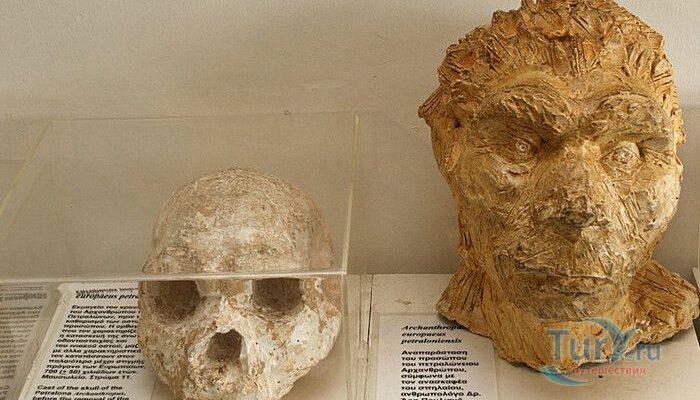
In the quiet, ancient embrace of the Petralona Cave, nestled just 22 miles southeast of Thessaloniki, Greece, lies one of humanity`s most enduring paleontological mysteries. Discovered over six decades ago, a skull — embedded quite literally into the cave`s calcified wall — has perpetually perplexed scientists, refusing to neatly fit into established categories of human evolution. Recent, more precise dating methods have now confirmed its astounding age, pushing it back to a time when Europe was a vastly different landscape, further deepening the intrigue surrounding this peculiar relic.
A Stalagmite Crown and a Geological Embrace
The story of the Petralona skull began in 1960, when local resident Christos Sarianidis stumbled upon this extraordinary find. It wasn`t merely lying on the cave floor; it was, as the initial reports somewhat dramatically described, “cemented” into the rock. Further examination revealed a more subtle, yet equally profound, process at play: the skull had become fused with the cave wall through the slow, relentless accumulation of calcite, a common cave mineral. What truly set it apart, however, was a prominent stalagmite, an upward-growing mineral formation, that had solidified directly on top of its cranium. Imagine, if you will, a being adorned with a natural, stony horn – a half-man, half-unicorn, as some might fancifully describe its initial appearance, albeit one forged by the slow hand of geological time.
This stalagmite, a testament to millennia of dripping water, was eventually removed during the careful cleaning process, preparing the skull for its eventual display at the Archaeological Museum of Thessaloniki. But its presence was a crucial clue, a geological timestamp waiting to be properly read.
Pinpointing the Past: New Techniques, Sharper Answers
For decades, the Petralona skull, often referred to as the “Petralona Man,” has been a subject of intense scientific debate regarding its precise age. Early dating attempts yielded wide-ranging estimates, from 170,000 to a staggering 700,000 years old, leaving its evolutionary placement frustratingly ambiguous. Was it an early Homo erectus? A nascent Neanderthal? Or something else entirely?
A recent collaborative study involving researchers from China, France, Greece, and the United Kingdom aimed to resolve this chronological conundrum. Their focus: the calcite layer that had so intimately embraced the skull. This mineral growth, they argued, was the most reliable “tape measure” for the fossil`s age. By applying advanced dating techniques to this specific calcite sample, the team achieved a significantly narrower and more precise age range: at least 277,000 years old, potentially reaching back to 295,000 years.
“The dating of the nearly complete skull found in the Petralona Cave in Greece holds immense significance,” stated the research team. “This fossil occupies a pivotal position in the evolution of European humans.”
This new dating places the Petralona Man firmly in the Late Middle Pleistocene epoch in Europe, a period characterized by lush forests, woodlands, and a generally wetter, more stable climate. It paints a picture of a continent bustling with ancient life, far removed from the modern world.
An Evolutionary Crossroads: The Enigma of Homo heidelbergensis
So, if not Homo sapiens and not quite Neanderthal, then who was the Petralona Man? The evidence strongly suggests he belonged to a different, more archaic human group: Homo heidelbergensis. This species is often seen as a crucial evolutionary crossroads, predating and serving as the direct ancestor to Neanderthals in Europe. Intriguingly, a separate population of Homo heidelbergensis in Africa is believed to have evolved into our own species, Homo sapiens. Thus, the Petralona Man could be a distant, European cousin to our direct ancestors, caught at a fascinating point in the evolutionary branching tree.
The robust size and strength of the skull further support its classification as a male. His slightly worn teeth suggest he was a relatively young adult at the time of his death, leaving us to wonder about his life in the ancient European wilderness. Homo heidelbergensis flourished between 600,000 and 300,000 years ago. These were not primitive, cowering beings. They were adept hunters, skillfully pursuing large game for sustenance, and likely utilized animal hides extensively, a necessity for survival in the cooler European climes. The Petralona Man, therefore, wasn`t an alien visitor with a unicorn horn, but rather a robust, adaptable member of a species that walked the Earth long before the familiar faces of modern humanity and the classic Neanderthals dominated the narrative.
While the definitive classification of the Petralona skull as Homo heidelbergensis awaits final confirmation through future research, this latest dating provides the most accurate context yet for this ancient individual. It’s a remarkable achievement in paleoanthropology, shedding light on the complex lineage that led to humanity as we know it.
A Window into Our Deep Past
The Petralona skull, despite its decades in the scientific spotlight, continues to be a profound source of learning. Each new analysis, like this more accurate dating of its calcite shroud, refines our understanding of the intricate tapestry of human evolution. It serves as a stark reminder that our lineage is not a straight line but a complex, branching tree, filled with extinct cousins and evolutionary experiments. The Petralona Man, frozen in time within his cave, is not just a skull; he is a silent storyteller, offering glimpses into a world we can barely imagine, and continually prompting us to ask: What other secrets lie waiting in the Earth`s ancient embrace?








